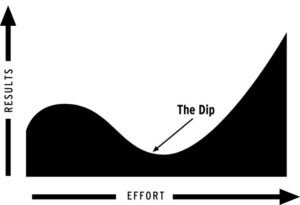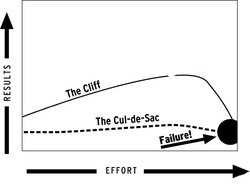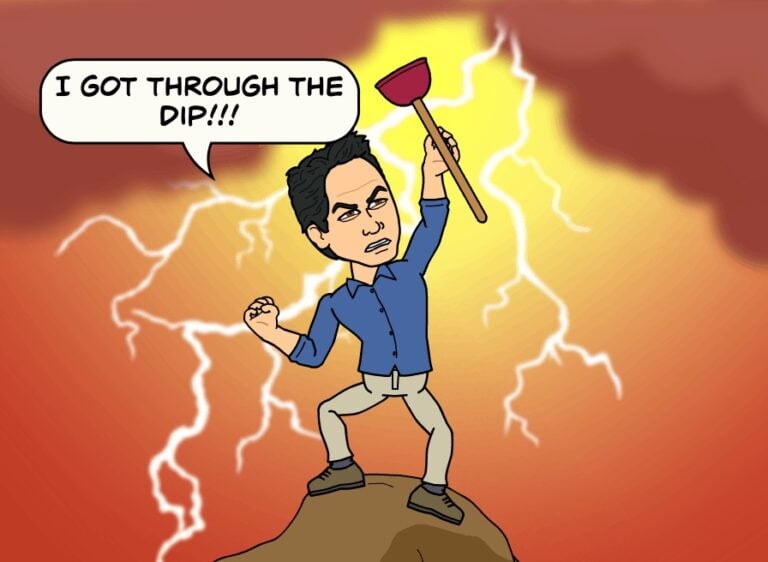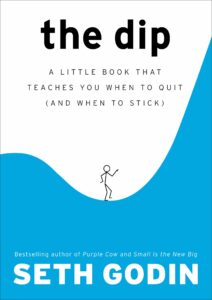I recently finished reading Seth Godin’s book, The Dip, for the 2nd time. It is a short book that teaches you when to quit and when to lean in. Seth makes the argument that strategic quitting is a huge part of success. The problem is that most people don’t know how to quit properly or even when to quit. Although the book is only 80 pages, it is jammed packed with wisdom.
What is the dip?
This is straight from the back flap of the book:
It’s the fifth job interview where they never even call you back.
It’s the garage band playing to an empty club in the middle of nowhere.
It’s the seventh time you fall on your butt while learning to snowboard.
It’s the middle of the marathon, when the excitement of the starting gun is a dim memory, and the joy of the finish line is a distant dream.
It’s any rough patch you have to get through before achieving your big goal…if in fact you’re chasing the right goal.
What else?
Oh yeah, it’s also the key to your career, your company’s future, and maybe your ultimate happiness.

The Dip is the up hill battle you face after your initial excitement and early success wears off when trying to master something new. Take starting a blog for example, what percentage of people do you think stick it out through the dip? According to a 2009 article by The New York Times, 95% of all blogs are abandoned by their authors. Now some of those authors were right to quit because they were not willing to pay the price for success. But some of those authors frankly gave up to soon. They gave up inches within riches.
The fact that most people give up too early is why you never really have to worry about the competition. When it comes to success, “the entire process is built around many people starting while most people quit.”
This is not to say that there are not things worth quitting. It is quite the opposite. The key to quitting right is recognizing first if you are chasing the right goal.
5 Questions to ask whether you should Quit it or Stick it out:
- Do you have enough passion to keep you going when the going gets tough?
- Is this something you think you can be the best in the world at?
- Are you willing to pay the price?
- Are you willing to quit other things to reach success? (there’s a reason why most CEO’s have horrible bowling averages)
- Are you sure the juice is worth the squeeze? Meaning, are you on a Dip Curve or one of the failure curves?
The Curves that Lead To Failure

The Cul-de-Sac and the Cliff are the curves you want to avoid and quit as soon as possible. It’s these two curves that lead to failure.
Seth describes the Cul-de-Sac as boring and the Cliff exciting (at least for a while), both of the curves get you to the dip and both lead to failure.
If you find yourself facing either of these two curves, you need to quit. Not soon, but right now. The biggest obstacle to success in life, as far as I can tell, is our inability to quit these curves soon enough. – page 22
They call them dead end jobs for a reason.
Don’t avoid quitting because your worried what others might think.
Get to the Dip and through the Dip
Yes, quitting means changing paths and that can be a hassle, but it’s a hassle worth dealing with. It’s the dip that leads to mastery and success, and ultimately to rewards. You know what they say “to the victor go the spoils.”
Important Note: Successful people don’t just ride out the Dip. They don’t just buckle down and survive it. No, they lean into the Dip. They push harder, changing the rules as they go. Just because you know you’re in the Dip doesn’t mean you have to live happily with it. Dips don’t last quite as long when you whittle at them. – page 19
If you really want success then you need to find the grit to persevere through the dip.
The dip creates scarcity, which creates value.
The Dip is actually your greatest ally because it makes the project worthwhile (and keeps others from competing with you). – page 33
Take solace when facing the dip, knowing that most of your competition will quit in the dip.
A final quote from the book on getting through the dip
The brave thing to do is to tough it out and end up on the other side–getting all the benefits that come from scarcity. And the stupid thing to do is to start, give it your best shot, waste a lot of time and money, and quit right in the middle of the Dip. – page 24
Now its your turn to get out there and pursue your passion and get through the dip so that you can reap the rewards just on the other side of the peak.
If you haven’t read this book, you can pick up a copy of the book on Amazon.
– Gen Y Finance Guy




12 Responses
Thanks for the book review. Sounds like a good suggestion.
My initial euphoria regarding my “9 to 5 escape” project wore off. Time to “lean into the dip”…
You got this EurFI!
The ‘dip’ is an interesting concept and as you mention through the review of this book, probably the place where most people would give up.
There’s another quote I like that relate to that “You become the successful person when everyone else has given up”.
Seems like a good book, I might put this on my wish list.
It is a great book and such an easy read.
I loved the Dip- it’s easily my favorite book by Seth Godin. I think the paths to success or failure were my favorite parts.
Personally, I’ve quit a huge number of projects, as I peered into the dip and thought, “Nah, that’s just going to suck.” I think it takes a while to find a project that you are really willing to slog through the dip.
Hey Hanna – It is really good to know whether you will have the desire and energy to get through the dip on a project. If not it’s best not to waste your time. Sounds like you have some really good self awareness.
When ever I am pursuing something new, I ask myself if I am willing to pay the price for success. If the answer is yes, then I know I can get through the inevitable dip. If the answer is no, I know that I need to quit before I ever really got started.
Cheers!
“Life can only be understood backward, but it must be lived forward.” -Soren Kierkegaard”
One of my favorite quotes at the moment, and there is a corollary in military-speak, “Stay left of the ‘Boom’!” GYFG, I assume you are familiar with the Gantt chart in your day-job, and it is accepted by owners, contractors, and the legal system for a very good reason. I would describe “The Dip” as a Change Order/Claim.:-)
Seriously, I enjoy Seth Godin and liked ‘Linchpin’ very much, but quite a bit of his material involves things he never had, or will have, to face. My favorite (for the wrong reasons) bit of advice in ‘Linchpin’ was to walk around handing out $20 bills to people who help you, and say “I wish it could be more.” I will read ‘The Dip’, and the concept has been around awhile; most people consider it “doing the actual work”. But knowing if you are on a Cliff or Cul-De-Sac trajectory can’t be known until it is too late. Not everyone is capable of greatness. Those 95% (I would put it at 99.9% on a long-enough timeline) of abandoned blogs should be abandoned. Getting ‘passionate’ about catering, or writing children’s books, or craft-brewing might feel good, but first you better have some money in the bank or a person who is willing to finance failure. For most, it is a lot safer to keep your dreams as dreams. Don’t want to throw negativity on the concept of ‘The Dip’ or Godin, but at some point we all have to “do the actual work” and no amount of reading or thinking or preparation will get those goals any closer. Continued success to you, GYFG!
Hey JayCeezy –
It is a tie between Linchpin or “What to do when it’s your turn” for my favorite pieces of Seth’s writings.
I partially agree that you can’t know for 100% accuracy whether you are on a Cliff or Cul-De-Sac trajectory. However, I would argue that a good bit of self-awareness goes a long way. I think a lot of people start things and give up because they didn’t ask themselves the critical question “am I willing to do the work necessary to succeed for the long term?” As you mentioned, there is no substitute for doing the actual work.
It is amazing how many blogs I have seen started and then abandoned in the short year that I have been doing this.
Talking about blogs and the Dip. It took me 3 years from the first time I had the idea of starting this blog and finally following through with it. Each time I quit before I ever started because I wasn’t sure I had it in me to get through the dip. But in September of 2014 I finally knew that I was willing to “Pay the Price.”
Your comment is very much appreciated. It is always nice conjure up conversation in the comments of a blog post.
Cheers!
BTW, I have a post coming out soon on savings rate. Our conversations on savings rate when we were working on your guest post really helped me solidify my own view on the importance of our savings rate (in relation to our savings goals), especially early on in the financial journey. It far outweighs the importance of compounding on my money at the moment.
I read this book a few years ago, but this review got me excited about it again! I may have to give this one a reread. It’s interesting to think about how quickly important lessons fall out of your head if you don’t review them periodically. Thanks for the write-up, it reminds me to persevere through the hard times if the project is worth it.
Hey Selina- This book is definitely worth a second read.
The one question I think this book reminds me to ask myself is “is the juice worth the sqeeze?”
Cheers!
If you’re not willing or the pay-off isn’t big enough, quit before you enter the Dip. If you begin the Dip, be prepared to persevere, because quitting in the middle is the worst waste of your effort and potential.